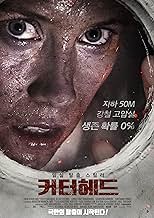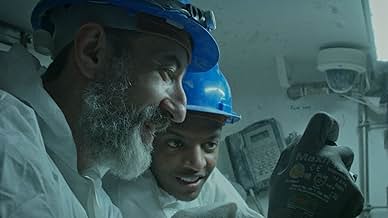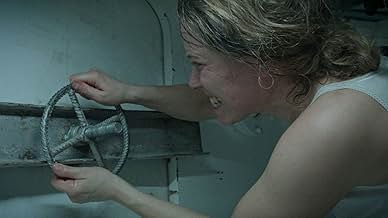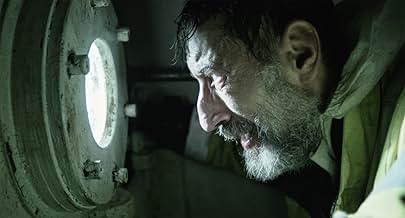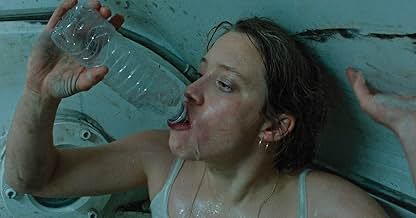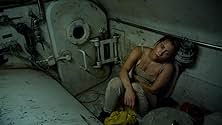Rie visite un tunnelier utilisé pour la construction du métro de Copenhague. Lorsqu'un accident se produit, elle doit survivre dans des conditions claustrophobes avec Ivo et Bharan.Rie visite un tunnelier utilisé pour la construction du métro de Copenhague. Lorsqu'un accident se produit, elle doit survivre dans des conditions claustrophobes avec Ivo et Bharan.Rie visite un tunnelier utilisé pour la construction du métro de Copenhague. Lorsqu'un accident se produit, elle doit survivre dans des conditions claustrophobes avec Ivo et Bharan.
- Réalisation
- Scénario
- Casting principal
- Récompenses
- 6 victoires et 16 nominations au total
Avis à la une
Cutterhead (2018)
An industrial accident occurs underground and people are trapped. The fear of death and the fight for survival are realistically based and not portrayed in an over the top fashion, like in many disaster movies. This is probably what would happen in real life. If you are looking for spectacle, seek out any recent catastrophe movie by Dwayne Johnson. This is more low key and in some ways uneventful, yet will still manage to hold your attention throughout. The filming in real locals gives the film a sense of realism and later, dread. 8 out of 10 stars.
An industrial accident occurs underground and people are trapped. The fear of death and the fight for survival are realistically based and not portrayed in an over the top fashion, like in many disaster movies. This is probably what would happen in real life. If you are looking for spectacle, seek out any recent catastrophe movie by Dwayne Johnson. This is more low key and in some ways uneventful, yet will still manage to hold your attention throughout. The filming in real locals gives the film a sense of realism and later, dread. 8 out of 10 stars.
It is quite difficult to know what people actually think, how they will react to certain situations and dangers and what degree of help they will be to others. In this case, it may start off as documentary, but it goes deeper than that (if you'll excuse the pun). And psychology will kick off at some point. Now if you are not impatient (which overall would not help while watching this movie, never mind being in the situation the characters find themselves in), you will find a very tension filled drama.
Our main character is more or less the viewer. Well the common viewer who may not have been underground and asks questions that some of the workers may not understand. If you are claustrophobic though, you may want to stay away from this. It can be quite upsetting ...
Our main character is more or less the viewer. Well the common viewer who may not have been underground and asks questions that some of the workers may not understand. If you are claustrophobic though, you may want to stay away from this. It can be quite upsetting ...
Saw this at the Brussels International Fantastic Film Festival 2019 (BIFFF for intimates). It is not a Horror or Thriller in the standard sense: no squeaking doors, no jump scares, no suddenly appearing ghosts, none of those clichés. Its tense may be felt nevertheless. We are constantly unsure how this story will end, given the deadly dangers awaiting the threesome we follow underground when disaster strikes.
Nice view on building operations underground, in this case construction works for the Copenhagen Metro. The setup looks like an organized chaos, but that is only the first impression and very unjust. These people know what they do, even when things go terribly wrong. And if all else fails, they can also count on salvage procedures and rescue teams. Panic and hasty decisions are out of the question, as theses are mostly counter productive.
Rie, our resident reporter, however, detests waiting for a rescue team. She wants action, even when it is risky, or when it violates regulations and safety procedures. She also goes against technical knowledge her fellow victims have, just wanting to do "something". She even lies about wanting to pee and needing some privacy, when in fact she prepares herself (out of sight) for an action the others would frown upon had they known her intentions.
Being there for PR purposes only, Rie's presence as a guest may be a nuisance, but she is a perfect vehicle for telling the story and following its developments from nearby. It gives us ample chance to understand why some things are done the way they are done in a working environment that we seldom get to see. As such, the screenplay is a success and seems the best (even the only??) way to sustain the story for one and a half hour, without risking to bore us. It clearly showcases the differences between people in Denmark, with Rie as piece de resistance in this movie, and the underground workers of all sorts of nationalities, who are there as the work pays very well (relative in their own country) and take the disadvantages (far away from family, problems with the language, risky and dirty working conditions) in addition and as inevitable.
Nice view on building operations underground, in this case construction works for the Copenhagen Metro. The setup looks like an organized chaos, but that is only the first impression and very unjust. These people know what they do, even when things go terribly wrong. And if all else fails, they can also count on salvage procedures and rescue teams. Panic and hasty decisions are out of the question, as theses are mostly counter productive.
Rie, our resident reporter, however, detests waiting for a rescue team. She wants action, even when it is risky, or when it violates regulations and safety procedures. She also goes against technical knowledge her fellow victims have, just wanting to do "something". She even lies about wanting to pee and needing some privacy, when in fact she prepares herself (out of sight) for an action the others would frown upon had they known her intentions.
Being there for PR purposes only, Rie's presence as a guest may be a nuisance, but she is a perfect vehicle for telling the story and following its developments from nearby. It gives us ample chance to understand why some things are done the way they are done in a working environment that we seldom get to see. As such, the screenplay is a success and seems the best (even the only??) way to sustain the story for one and a half hour, without risking to bore us. It clearly showcases the differences between people in Denmark, with Rie as piece de resistance in this movie, and the underground workers of all sorts of nationalities, who are there as the work pays very well (relative in their own country) and take the disadvantages (far away from family, problems with the language, risky and dirty working conditions) in addition and as inevitable.
In the opening scene of Cutterhead, as protagonist Rie rides a construction site elevator deep into the Danish underground, we glimpse the elevator's control panel and its "up" and "down" buttons that some joker has labeled "Heaven" and "Hell" in felt pen, setting the stage for the claustrophobic horror that's to come.
As a copywriter for the Copenhagen metro, she's there to write the kind of breezy PR texts that might excitedly describe the metro as "the largest construction project in the Danish capital in 400 years", and frame having workers of 24 different nationalities as a "great European coming together" (rather than the result of working conditions and pay that no Danish construction worker would accept). Her interviewees aren't playing along, though. "What's the best part of your job?" she asks every worker she approaches, but most give polite non-answers (clearly trying to avoid trouble), if they even speak English. Only Ivo, who's from Croatia and maintains the cutterhead, doesn't hesitate. "The money," he answers, dispelling any romantic notions of a labor of love.
These workers are all here, working a bad job with bad pay and bad working conditions, because they need the money. But why is Rie here? The question lingers throughout the movie. When one character questions if she's even allowed, Ivo explains "She's from the office". In other words, she's Danish. "I have permission to go anywhere", Rie helpfully adds.
Ivo and his colleague Bharan work the cutterhead because it's more dangerous, and hence pays more. Even then, Rie undoubtedly earns more than either of them. The disaster that soon engulfs these three people should erase these differences, but the sense of disparity persists, and it's in these clashes between worlds that Cutterhead becomes more than a disaster movie with a novel setting, and shows real bite with its social critique.
As a copywriter for the Copenhagen metro, she's there to write the kind of breezy PR texts that might excitedly describe the metro as "the largest construction project in the Danish capital in 400 years", and frame having workers of 24 different nationalities as a "great European coming together" (rather than the result of working conditions and pay that no Danish construction worker would accept). Her interviewees aren't playing along, though. "What's the best part of your job?" she asks every worker she approaches, but most give polite non-answers (clearly trying to avoid trouble), if they even speak English. Only Ivo, who's from Croatia and maintains the cutterhead, doesn't hesitate. "The money," he answers, dispelling any romantic notions of a labor of love.
These workers are all here, working a bad job with bad pay and bad working conditions, because they need the money. But why is Rie here? The question lingers throughout the movie. When one character questions if she's even allowed, Ivo explains "She's from the office". In other words, she's Danish. "I have permission to go anywhere", Rie helpfully adds.
Ivo and his colleague Bharan work the cutterhead because it's more dangerous, and hence pays more. Even then, Rie undoubtedly earns more than either of them. The disaster that soon engulfs these three people should erase these differences, but the sense of disparity persists, and it's in these clashes between worlds that Cutterhead becomes more than a disaster movie with a novel setting, and shows real bite with its social critique.
When I first started watching this the photography quality and overall impression was one of "oh no this looks like a BBC docudrama" but my fears were soon quashed as it turns out this is a rather unique and really quite interesting adventure into the realms of human frailty and if you suffer from fear of small spaces I would issue a warning on this film as it presents quite a realistic claustrophobic atmosphere especially in the closing 30 minutes.
It is not a crash, bang, wallop movie with oodles of CGI and action and 5 star actors but it is more of a study of human frailty when confronted by disaster and it does it in quite a more honest way than most movies have in the past and is down and dirty with no frills or spills. I fear most people will find it tedious but give it a chance and watch it to the end and you might just be surprised.
It is not a crash, bang, wallop movie with oodles of CGI and action and 5 star actors but it is more of a study of human frailty when confronted by disaster and it does it in quite a more honest way than most movies have in the past and is down and dirty with no frills or spills. I fear most people will find it tedious but give it a chance and watch it to the end and you might just be surprised.
Le saviez-vous
- AnecdotesThe film was edited using method-editing in a very small, dark and extremely hot editing suite called "Slum Suiten".
Meilleurs choix
Connectez-vous pour évaluer et suivre la liste de favoris afin de recevoir des recommandations personnalisées
- How long is Cutterhead?Alimenté par Alexa
Détails
Box-office
- Budget
- 4 300 000 DKK (estimé)
- Durée1 heure 24 minutes
- Couleur
- Rapport de forme
- 1.85 : 1
Contribuer à cette page
Suggérer une modification ou ajouter du contenu manquant


